GemTek Technology M940125G Wireless LAN Broadcom 11g mini PCI User Manual
Gemtek Technology Co., Ltd. Wireless LAN Broadcom 11g mini PCI Users Manual
Users Manual

Wireless LAN 802.11g
User's Manual
Version 1.0

User’s Guide
1
Copyright statement
No part of this publication may be reproduced, stored in a retrieval system, or transmitted in any form
or by any means, whether electronic, mechanical, photocopying, recording, or otherwise without the
prior writing of the publisher.
April 2004

User’s Guide
2
Contents
1. Introduction
_________________________________________________________________ 3
2. Wireless LAN Basics
_________________________________________________________ 4
3. Installation for Windows platform
______________________________________________ 5
3.1. Installation Overview
____________________________________________________________6
3.2. Install Procedure for Windows XP
_______________________________________________7
3.3. Install Procedure for Windows 98/ME/2000
______________________________________9
4. Configuration Utility
_________________________________________________________ 17
4.1 Link Information
_________________________________________________ 錯誤
錯誤錯誤
錯誤! 尚未定義書籤
尚未定義書籤尚未定義書籤
尚未定義書籤。
。。
。

User’s Guide
3
1. Introduction
Thank you for purchasing your Wireless LAN 802.11g Adapter. This Quick Installation Guide will assist
you with the installation procedure.
The package you have received should contain the following items:
• Wireless LAN 802.11g Adapter
• Quick Installation Guide
• CD containing Wireless LAN Management utility, drivers and Multi-lingual User’s Guide
Note: if anything is missing, please contact your vendor
The CD contains drivers and Configuration Utility program that is used for managing the Wireless LAN
Adapters and establishing the wireless connection with your Local Area Network.
Note: This manual is valid for all Wireless LAN 11g Series products, such as PC Card, USB, mini-USB,
PCI adapter, mini-PCI…etc.

User’s Guide
4
2. Wireless LAN Basics
Wireless LAN (Local Area Networks) systems offer a great number of advantages over a traditional,
wired system. Wireless LANs (WLANs) are more flexible, easier to setup and manage and often more
cost effective than their wired equivalence.
Using radio frequency (RF) technology, WLANs transmit and receive data over the air, minimizing the
need for wired connections. Thus, WLANs combine data connectivity with user mobility, and, through
simplified configuration, enable movable LANs.
With wireless LANs, users can access shared information without looking for a place to plug in and
network managers can set up or augment networks without installing or moving wires. Wireless LANs
offer the following productivity, convenience and cost advantages over traditional wired networks:
• Mobility - Wireless LAN systems can provide LAN users with access to real-time information
anywhere in their organization. This mobility supports productivity and service opportunities not
possible with wired networks.
• Installation Speed and Simplicity - Installing a wireless LAN system can be fast and easy and can
eliminate the need to pull cable through walls and ceilings.
• Installation Flexibility - Wireless technology allows the network to go where wires cannot go.
• Reduced Cost-of-Ownership - While the initial investment required for wireless LAN hardware
might be higher than the cost of wired LAN hardware, overall installation expenses and life-cycle
costs will be significantly lower. Long-term cost benefits are greatest in dynamic environments
requiring frequent moves, adds, and changes.
• Scalability - Wireless LAN systems can be configured in a variety of topologies to meet the needs
of specific applications and installations. Configurations are easily changed and range from peer-
to-peer to full infrastructure networks, also allow roaming over a broad area.

User’s Guide
5
3. Installation for Windows platform
The following section will assist you in installing wireless LAN Adapter successfully. You will first install
software (Utility) and then insert / attach the Wireless LAN Adapter to your system, and finally set the
network properties to accommodate resource sharing and select the type of wireless network that you
wish to install. The Wireless LAN card can easily be installed and used, without bothering to connect
cables for keeping your computer to use network resources.

User’s Guide
6
3.1. Installation Overview
Here are some steps you will perform in establishing your wireless network connection:
! Install the Access Point at first. AP is needed in case of Infrastructure network mode.
! Install the software using the Install CD.
! Install the Wireless LAN Card (WIRELESS LAN 802.11g Adapter).
! Install the network protocol(s) required to communicate on your network. Most likely you will need
the TCP/IP protocol.

User’s Guide
7
3.2. Install Procedure for Windows XP
1. Insert the given Installation CD in the CD-ROM and then click on the Install Config Utilities.
Follow the instruction to finish the installation.
2. Insert your WLAN card into PCMCIA/PCI slot or USB connector of your system, and then system
will detect new hardware.
Select “Install the software automatically (Recommended) ”, and then click Next to continue.
Note: Do not insert the WLAN Adapte
r
until you are asked to do so, failure of which may result in unsuccessful
installation of your WLAN device.
Important Notice
In order to make right use of WPA, please ensure that your current Wireless Adapter’s driver, and
Wireless Utility can support it, WPA needs 802.1x authentication (when RADIUS mode is chosen),
though the Operating System must also support 802.1x protocol. For Microsoft’s OS family, only
Windows XP has incorporated this by default. The rest of the OS must installed 3er party’s client
software such as Funk ODySSey.

User’s Guide
8
Once your system detected the driver, Microsoft will show a warning message as below.
Click “ Continue Anyway ” for next step.
After copy the file to your system, then the setup is finish.
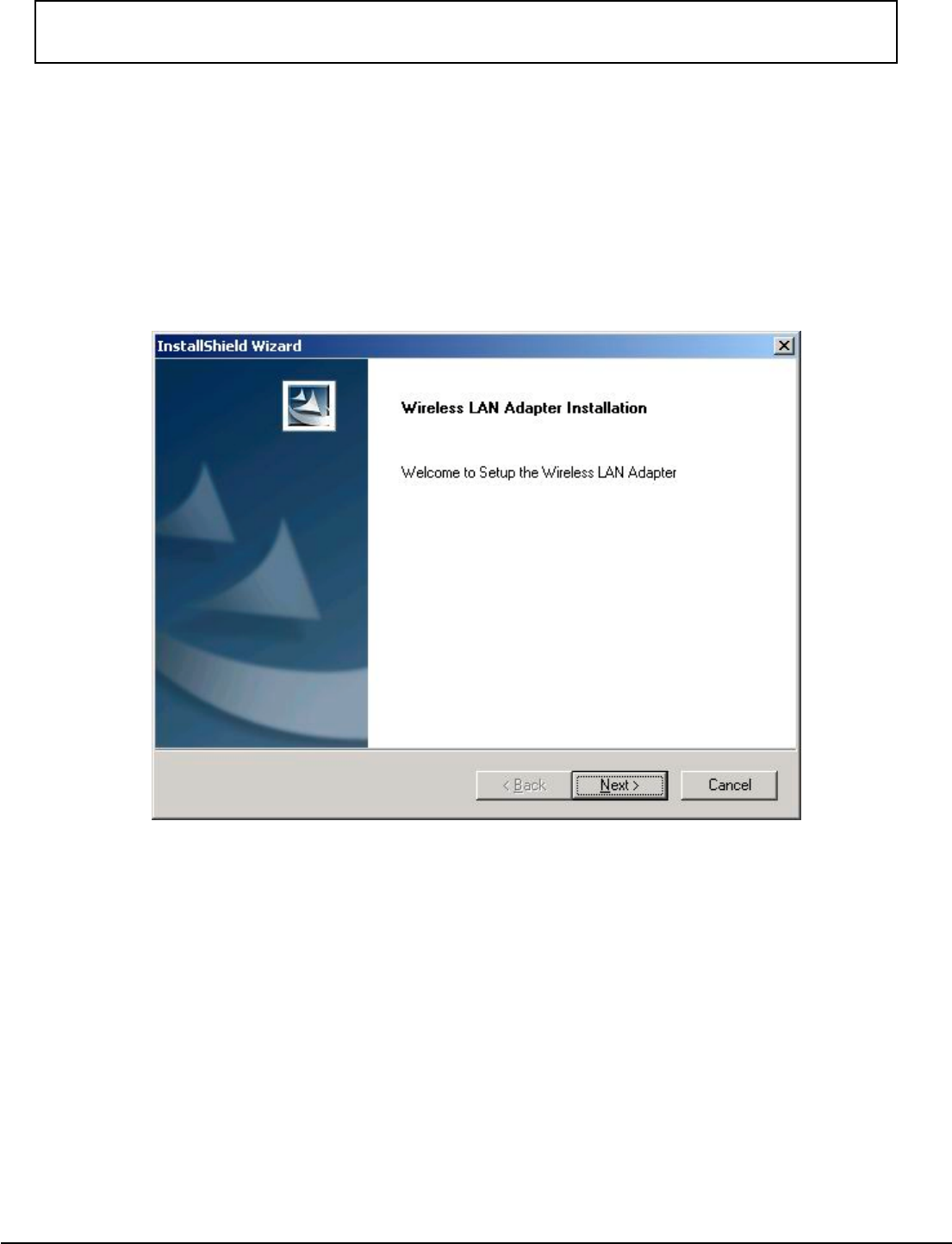
User’s Guide
9
3.3. Install Procedure for Windows 98/ME/2000
Please follow the following steps one by one in order to install the WLAN Adapter successfully.
1. Power on your computer and allow Windows 98/ME/2000 to load fully.
2. Be sure that the Wireless LAN 802.11g Adapter is not inserted yet.
3.
Insert the given Installation CD in the CD-ROM and then click on the Install Config Utilities.
At the “ Welcome” window, click Next.
Note: Do not insert the WLAN Adapte
r
until you are asked to do so, failure of which may result in unsuccessful
installation of your WLAN device.
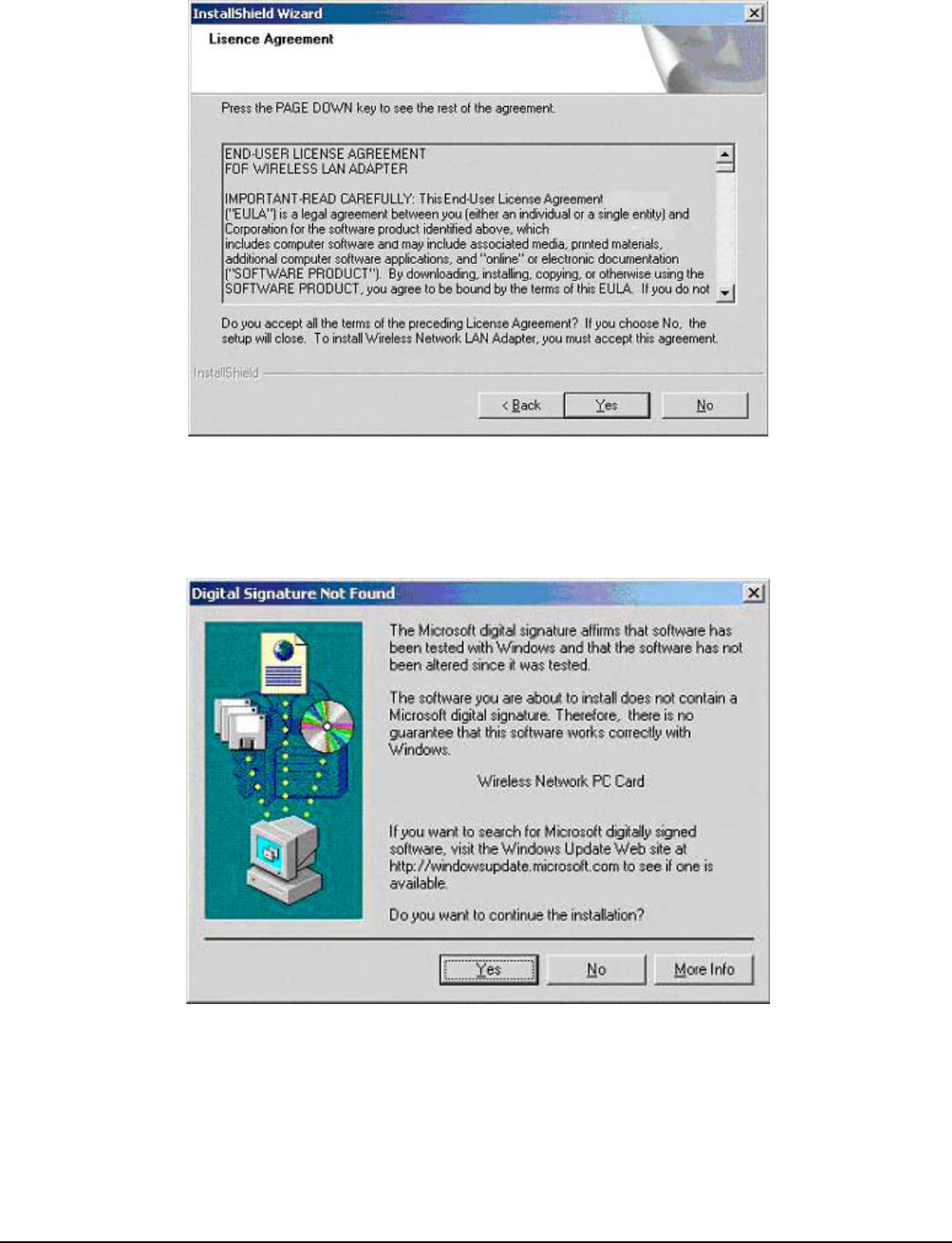
User’s Guide
10
4. Accept the license agreement.
Accept the license agreement. Click Yes to accept.
Click Yes to finish the setup.

User’s Guide
11
5. Insert / attach Wireless LAN 802.11g Adapter to your system
Windows will recognize the WLAN adapter and auto detect the driver, if the system did not find the
driver automatically, please install the driver manually.
Click Yes to finish the installation.
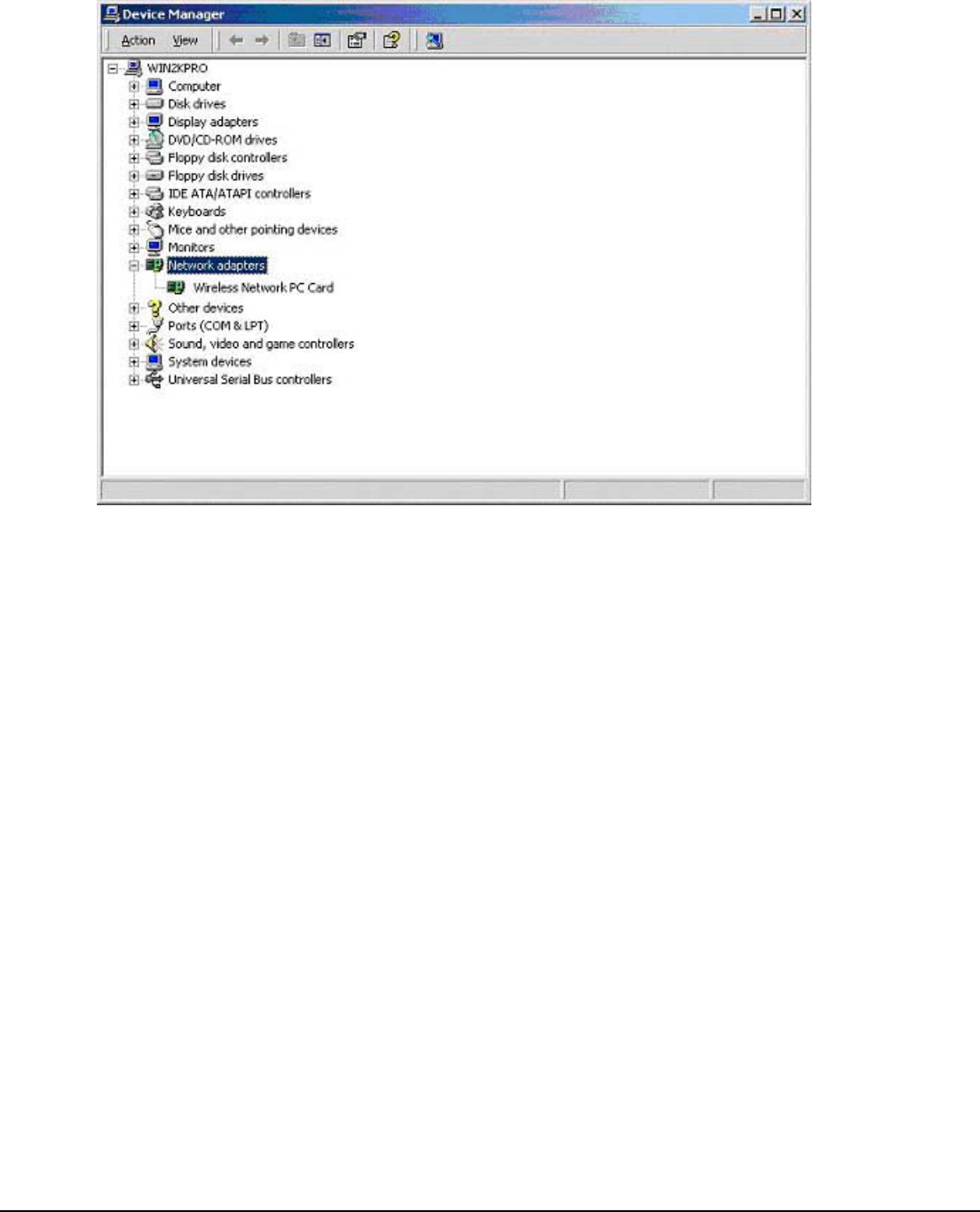
User’s Guide
12
6. Click the right button of mouse on My Computer "
""
" Properties "
""
" Hardware"
""
"Device Manager.
Check whether it has WLAN adapter in one of the sockets or not. If you find Wireless Network PC
Card in one of the sockets, it means the card is detected properly.
7. Click right button of mouse on the Network Neighborhood.
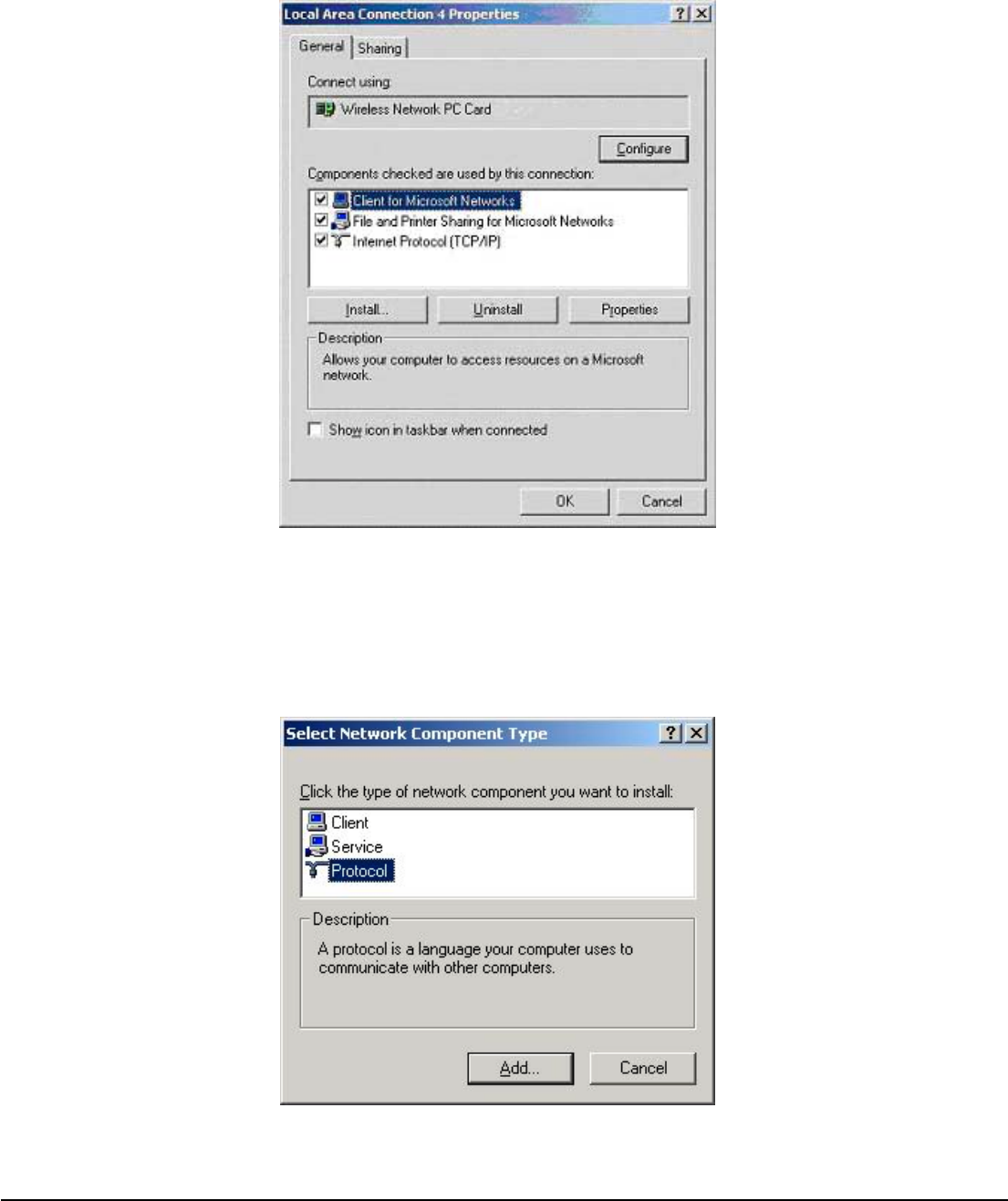
User’s Guide
13
8. Select Properties from the pop up menu. For Windows 98 the network’s properties box appears.
* For Windows ME and 2000, please select the Local Area Connection’s properties to check the
following menu.
9. Click on the General tab and then click on the Install button. Select Network Component Type box
appears. Click on the Protocol then click the Add button.
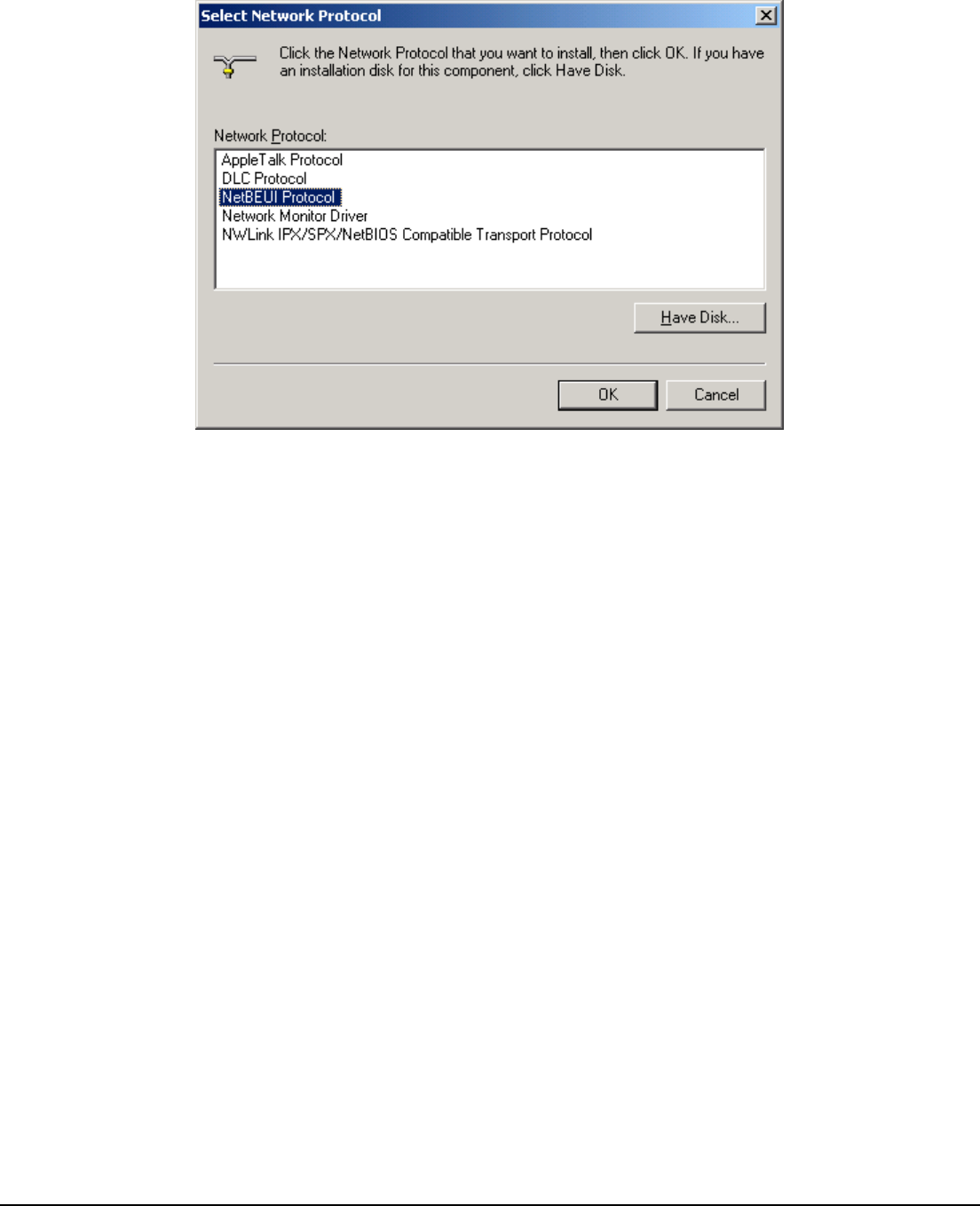
User’s Guide
14
10. Select Network Protocols box appears. From the list of network protocols list, select NetBEUI, then
click OK.
11. The NetBEUI protocol is now installed. After clicking on OK return back to Network Component
Type box.
12. Repeat the step 9 and 10 to add IPX/SPX protocol.
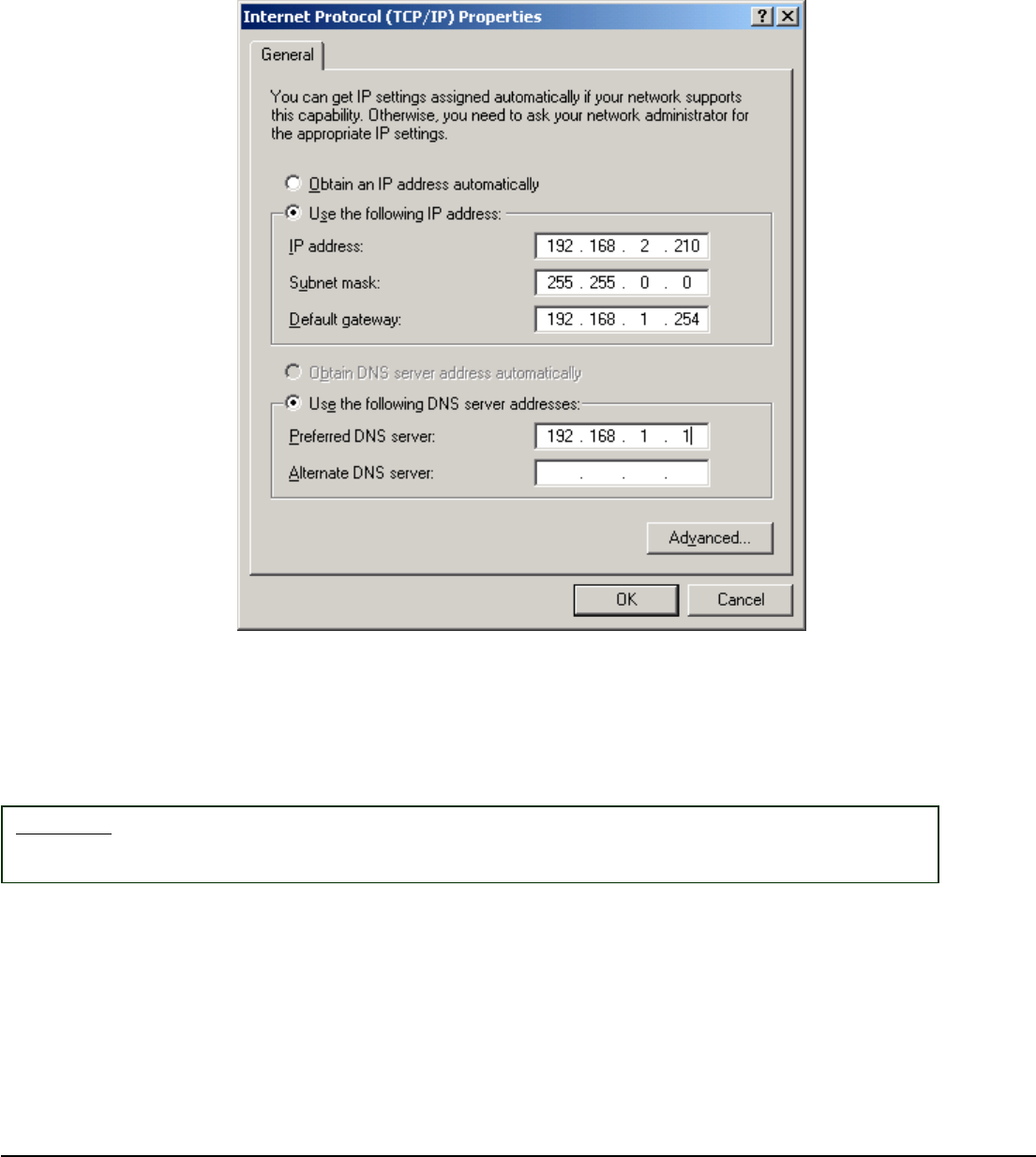
User’s Guide
15
13. Click on the TCP/IP option for setting the IP address for your computer. You can select either
Obtain an IP address automatically or Use the following IP address setting. If your choice is the
second one then enter the IP value, Subnet masking, DNS, Domain/ Workgroup name, and
Gateway Address values. After setting these parameters appropriately, click OK to return to
Network Component Type and you can select the File and Printer Sharing options as well for
sharing your computers resources. Click on OK.
14. Screen message do want to restart your Computer will pop up. Select Yes. It will shut down your
computer and restart.
Important: In order to make sure that the changed values could take effect, please Restart
your computer before continue.
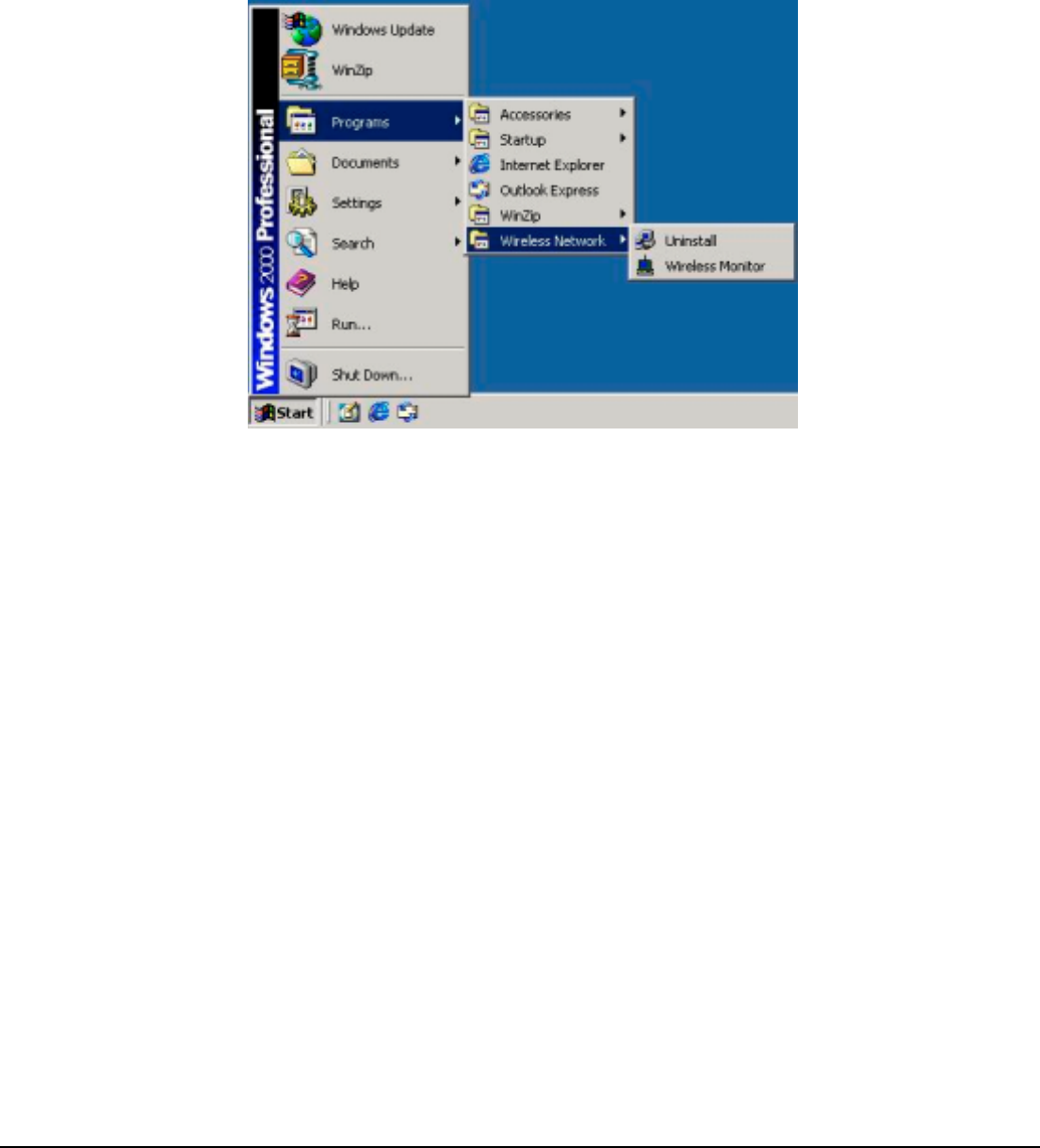
User’s Guide
16
Uninstall Procedure
Step 1:
If you want to uninstall the WLAN adapter, just simply click
Start Menu " Program " Wireless Network "
""
" Uninstall,
it shall uninstall all related programs.
Step 2:
Restart your Computer.

User’s Guide
17
4. Configuration Utility
Wireless LAN 802.11g Wireless LAN adapter uses its own management software. All functions
controlled by user are provided by this application. Usually this application starts automatically,
or click icon from Start Menu to start the Utility application.
A new icon - should appear in your Icon tray. If the icon is in red, it means that Wireless LAN
802.11g NIC configuration is invalid or incomplete. Sometimes icon can be colored in yellow. This may
happen when communication is defined poor connection or incorrectly.
Figure 1 Icon tray with a new icon

User’s Guide
18
4. 1 Link Information
This field is used to display the current status of connection. When the state shows “Connected to
Network“ means normal flow of operation in Infrastructure mode. The PC is connected to access
point. Networking is available.
A state of “Scanning” means that the node is searching for available access point and detecting
the SSID for an available access point within range.
This field will also display an error message for some reason if the driver fails to initialize.
Network Type
Infrastructure Mode - The driver will scan all available channels continuously until it finds one or
more Access Points that match its SSID. At that point it will try and authenticate and
associate with the Access Point.
Peer to Peer Mode - The driver will scan for 5 seconds looking for an existing Ad Hoc network
using the same SSID.
- Current Channel and Transmit Rate
Shows the channel of the radio and transmit rate being currently used for an active connection.
This value has no meaning when the radio is “Scanning”
- Link Quality
The Link Quality bar graph is only active when the node is in Infrastructure Mode. The bar graph
displays the quality of the link between the node and Access Point.
-
Signal Strength
The Signal Strength bar graph is only active when the node is in Infrastructure Mode. The bar
graph displays normalized signal strength as reported by the radio, averaged over all frames over
100 bytes long that are received from the Access Point.
Federal Communication Commission Interference Statement
This equipment has been tested and found to comply with the limits for a Class B digital device,
pursuant to Part 15 of the FCC Rules. These limits are designed to provide reasonable
protection against harmful interference in a residential installation. This equipment generates,
uses and can radiate radio frequency energy and, if not installed and used in accordance with
the instructions, may cause harmful interference to radio communications. However, there is no
guarantee that interference will not occur in a particular installation. If this equipment does cause
harmful interference to radio or television reception, which can be determined by turning the
equipment off and on, the user is encouraged to try to correct the interference by one of the
following measures:
- Reorient or relocate the receiving antenna.
- Increase the separation between the equipment and receiver.
- Connect the equipment into an outlet on a circuit different from that to which the receiver is
connected.
- Consult the dealer or an experienced radio/TV technician for help.
FCC Caution: To assure continued compliance, any changes or modifications not expressly
approved by the party responsible for compliance could void the user's authority to operate this
equipment.
This device complies with Part 15 of the FCC Rules. Operation is subject to the following two
conditions: (1) This device may not cause harmful interference, and (2) this device must accept
any interference received, including interference that may cause undesired operation.
Statement Needed to be Shown on End Product
Since this module is installed inside the end product, the end product should be affixed a label on
visible area showing that this product contain a RF module, and also its FCC ID.
IMPORTANT NOTE:
FCC Radiation Exposure Statement:
This equipment complies with FCC radiation exposure limits set forth for an uncontrolled
environment. This equipment should be installed and operated with minimum distance 20cm
between the radiator & your body.
This transmitter must not be co-located or operating in conjunction with any other antenna or
transmitter.
The OEM integrator has to be aware not to provide information to the end user regarding how to
install or remove this RF module in the users manual of the end product which integrate this
module.

This device is intended only for OEM integrators under the following conditions:
1) The antenna must be installed such that 20 cm is maintained between the antenna and users, and
2) The transmitter module may not be co-located with any other transmitter or antenna.
As long as the 2 conditions above are met, further transmitter testing will not be required. However,
the OEM integrator is still responsible for testing their end-product for any additional compliance
requirements required with this module installed (for example, digital device emissions, PC peripheral
requirements, etc.).
IMPORTANT NOTE: In the event that these conditions can not be met (for example certain laptop
configurations or co-location with another transmitter), then the FCC authorization is no longer
considered valid and the FCC ID can not be used on the final product. In these circumstances, the
OEM integrator will be responsible for re-evaluating the end product (including the transmitter) and
Obtaining a separate FCC authorization.
End Product Labelling
This transmitter module is authorized only for use in devices where the antenna may be installed such
that 20 cm may be maintained between the antenna and users (for example digital device emissions,
PC peripheral requirements, etc...). The final end product must be labeled in a visible area with the
following: “ Contains TX FCC ID: MXF-M940125G”.
Manual Information That Must be Included
The users manual for end users must include the following information in a prominent location “
IMPORTANT NOTE: To comply with FCC RF exposure compliance requirements, the antenna used for
this transmitter must be installed to provide a separation distance of at least 20 cm from all persons and
must not be co-located or operating in conjunction with any other antenna or transmitter.”
Gemtek declares that WMIB-100GS (MXF-M940125G) is limited in CH1~CH11 by specified firmware
controlled in USA.